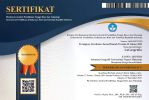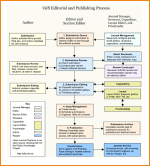Implementasi Model Instalasi Pengelolaan Air Limbah dengan Menambahkan Berbentuk (L) Setiap Tangki
(1) Politeknik Pariwisata Makassar
(2) Universitas Negeri Makassar
(3) Politeknik Pariwisata Makassar
(4) Politeknik Pariwisata Makassar
(*) Corresponding Author
DOI: https://doi.org/10.35580/lageografia.v18i3.12568
Abstract
The importance of this research is to provide a new development in the form of the development of the addition of L-shaped pipe accessories added to the pipe in each tank from previous studies, Implementation of previous research has not been maximized when used in the kitchen of Makassar Tourism Polytechnic so that modifications are made, because it is not there is a difference in waste from each tank, furthermore this research uses research and development research methods with the development of existing models by not build the new construction from scratch, while the development of this research is to add pipes in the form (L) or L-shaped pipe attached to the tank number one (1) as the first tank for waste that is disposed of often containing foam soap, fat and heavy sediments, then in the second tank (2) which already does not contain foam, grease, and heavy sediments, reattach the L pipe to reduce the content is what if it still exists, then add sand material, and gravel, as the dissolved material Chemical Oxygen Demands (COD) dissolved in the third tank (3) before being channeled into the public sewer. This research recommends that before disposal of liquid waste from processed food, it is better to do the separation of the sediment contained in the liquid waste and then to develop it further to get more perfect results, especially the criteria for Wastewater Clarity.
Keywords
Full Text:
PDFReferences
Adimalla et al. N. Adimalla, S.K. Vasa, P. Li., (2018)Evaluation of groundwater quality, Peddavagu in Central Telangana (PCT), South India: an insight of controlling factors of fluoride enrichment Model
Earth Syst Environ (2018), 10.1007/s40808-018-0443-z Google Scholar
Adimalla N, Venkatayogi S (2017) Mechanism of fluoride enrichment in groundwater of hard rock aquifers in Medak, Telangana State, South India. Environ Earth Sci 76:45. https://doi.org/10.1007/s12665-016-6362-2CrossRefGoogle Scholar
Adimalla N, Venkatayogi S (2018) Geochemical characterization and evaluation of groundwater suitability for domestic and agricultural utility in the semi-arid region of Basara, Telangana State, South India. App Water Sci 8(1). https://doi.org/10.1007/s13201-018-0682-1
APHA, 2017 APHAStandard Methods for the Examination of Water and Wastewater
(23rd ed.), American Public Health Association, Washington D.C (2017), Google Scholar
Avci et al. H. Avci, U.E. Dokuz, A.S.(2018), AvciHydrochemistry and groundwater quality in a semiarid calcareous area: an evaluation of major ion chemistry using a stoichiometric approach Environ. Monit.
Assess., 190 (2018), p. 641, 10.1007/s10661-018-7021-8, Google Scholar
B.U. Ukah, J.C. Egbueri, C.O. Unique, O.E. Ubido,(2019).Extent of heavy metals pollution and health risk assessment of groundwater in a densely populated industrial area, Lagos, Nigeria. Int J Energy
Water Res (2019), 10.1007/s42108-019-00039-3, Google Scholar
J.W. Collin, N.P. Jennifer, M. John, M.C. Christopher, G. Scott,
J.A.Lynch, (2018).Estimating base cation weathering rates in the USA: challenges of uncertain soil mineralogy and specific surface area with the application of PROFILE model, Water Air Soil Pollut.,
(3) (2018), pp. 61-90, Google Scholar
J.C. Egbueri,(2018).Assessment of the quality of groundwaters proximal to dumpsites in Awka and Nnewi metropolises: a comparative approach, Int J Energ Water Res (2018), 10.1007/s42108-018-0004-1, Google Scholar
J.C. Egbueri,(2019)a. Water quality appraisal of selected farm provinces using integrated hydrogeochemical, multivariate statistical, and microbiological technique model Earth Syst Environ (2019), 10.1007/s40808-019-00585-google Scholar
J.C. Egbueri,(2019)b. Evaluation and characterization of the groundwater quality and hydrogeochemistry of Ogbaru farming district in southeastern Nigeria, SN Appl Sci (2019), 10.1007/s42452-019-0853-1, Google Scholar
J.C. Egbueri,(2019)c. Groundwater quality assessment using pollution index of groundwater (PIG), ecological risk index (ERI) and hierarchical cluster analysis (HCA): a case study ground. Sustain.
Dev. (2019), 10.1016/j.gsd.2019.100292, Google Scholar
Li, A., Wei, X., & He, Z. (2020). Robust Proof of Stake: A New Consensus Protocol for Sustainable Blockchain Systems. Sustainability, 12(7), 2824. https://doi.org/10.3390/su12072824
Musawantoro, M. (2018). ANALISIS PERILAKU KARYAWAN RESTORAN DALAM MENGELOLAH SAMPAH ORGANIK DI KOTA MAKASSAR. UPPM Akpar Makassar, 09(01). https://doi.org/http://dx.doi.org/10.2139/ssrn.3270741
Musawantoro, M., & Shafany, M. (2019). Wastewater Analysis in The Kitchen Practice At Makassar Tourism Polytechnic. 18(1), Open Journal of Statistics 18(https://ojs.unm.ac.id/Lageografia):82-89, DOI: 10.35580/lageografia.v18i1.11131 82–89.
N. Subba Rao, Maya Chaudhary,(2019). Hydrogeochemical processes regulating the spatial distribution of groundwater contamination, using pollution index of groundwater (PIG) and hierarchical cluster analysis (HCA): a case study Ground. Sustain. Dev. (2019), 10.1016/j.gsd.2019.100238Google Scholar
Rizal, R. (2017). Rancang Bangun Model Teknologi Instalasi Pengolahan Air Limbah ( IPAL ). Bina Teknika, 12(2), 165–176.
R. Paul, K. Brindha, G. Gowrisankar, M.L. Tan, M.K,(2019) SinghIdentification of hydrogeochemical processes controlling groundwater quality in Tripura, Northeast India using evaluation indices, GIS, and multivariate statistical methods Environ. Earth Sci. (2019), 10.1007/s12665-019-8479-6,Google Scholar
Syarif, E. (2018). Representasi Aturan Adat dalam Pengelolaan Hutan Masyarakat Adat Ammatoa Sulawesi Selatan. Jurnal Environtmental Science, 1(April).
S.O. Onwuka, C.K. Ezugwu,(2019). Multivariate statistical assessment and spatial distribution of groundwater contamination in Nike and its environs, South-Eastern Nigeria Int J Phys Sci, 14 (8) (2019), pp. 62-80, CrossRefGoogle Scholar
T. Chen, H. Zhang, C. Sun, H. Li, Y,(2018) GaoMultivariate statistical approaches to identify the major factors governing groundwater quality, Appl Water Sci (2018), 10.1007/s13201-018-0837-0, Google Scholar
Vebrianti1, La Ode Amaluddin2, R. M. (2019). Deskripsi Tentang Pemanfaatan Sumber Mata Air Jompi Kelurahan Laende Kecamatan Katobu Kabupaten Muna. 18(1), 55–63.
Vollprecht, D., Krois, L. M., Sedlazeck, K. P., Müller, P., Mischitz, R., Olbrich, T., & Pomberger, R. (2019). Removal of critical metals from waste water by zero-valent iron. Journal of Cleaner Production, 208, 1409–1420. https://doi.org/10.1016/j.jclepro.2018.10.180
Article Metrics
Abstract view : 324 times | PDF view : 56 timesRefbacks
- There are currently no refbacks.
Copyright (c) 2020 Muhammad Musawantoro

This work is licensed under a Creative Commons Attribution-NonCommercial-NoDerivatives 4.0 International License.
LaGeografia: Jurnal Program Studi Pendidikan Geografi, Jurusan Geografi, Fakultas MIPA, Universitas Negeri Makassar.
Email: lageografia@unm.ac.id | +6285298749260
Editorial Office













































